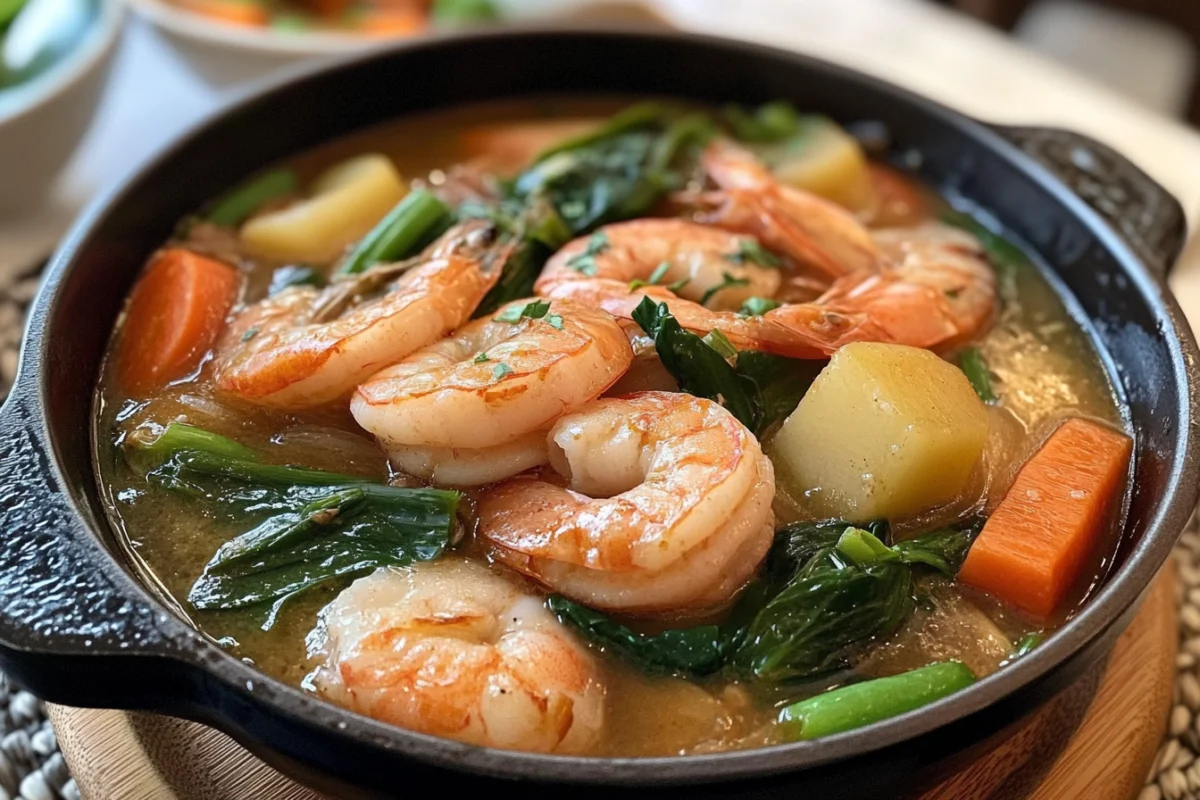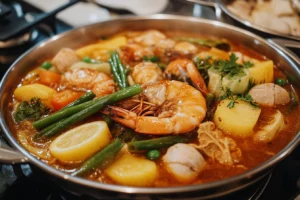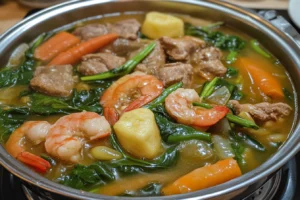Learn the authentic how to cook sinigang step by step brainly with our comprehensive guide. Perfect your Filipino favorite today!
Sinigang is a beloved Filipino soup known for its tangy broth and rich flavors. This guide provides a detailed, step-by-step process on how to cook sinigang step by step brainly, ensuring a delicious and authentic experience.
For a detailed list of ingredients, you can refer to the article on What is Sinigang Made Of?.
What is Sinigang?
Sinigang is a traditional Filipino soup characterized by its sour broth, typically made with tamarind, tomatoes, and various vegetables. It is a staple in Filipino households, celebrated for its comforting and hearty nature. How to cook sinigang step by step brainly involves understanding its origins and the versatility of its ingredients.
Regional Variations
Different regions in the Philippines have their unique takes on sinigang. For instance, some areas prefer using guava or calamansi instead of tamarind for the sourness. Additionally, the choice of protein varies, with options like beef, shrimp, fish, or beef being popular.
Sinigang sa Bayabas
In some regions, guava (bayabas) is used as the souring agent, offering a unique sweetness that balances the savory elements of the soup. This variation is particularly popular in areas where guava is abundant.
Sinigang sa Sampalok
Sampalok, or tamarind, remains the most traditional souring agent. However, regions may use different types of tamarind or even combine it with other sour fruits to enhance the flavor.
Common Types of Sinigang
- Sinigang na Baboy (Beef Sinigang)
- Sinigang na Hipon (Shrimp Sinigang)
- Sinigang na Isda (Fish Sinigang)
- Sinigang na Baka (Beef Sinigang)
Each type offers a distinct flavor profile while maintaining the signature tangy broth. For example, Sinigang na Baka tends to have a richer flavor due to the beef’s robust taste, whereas Sinigang na Hipon is lighter and seafood-centric.
Ingredients Needed
To master how to cook sinigang step by step brainly, gather the following ingredients:
Main Ingredients
- Protein Choices
- Shrimp: Fresh or frozen. Deveined shrimp work best for a cleaner taste.
- Fish: Bangus (milkfish) or other white fish like tilapia or snapper.
- Beef: Cuts like brisket or shank for a hearty broth.
- Vegetables
- Radish (labanos)
- Eggplant (talong)
- Okra (okra)
- Water spinach (kangkong)
- Tomatoes
- Long green beans (sitaw)
- Daikon (optional)
- Spinach or mustard greens (optional)
Sinigang Broth Essentials
- Tamarind Base: Fresh tamarind, tamarind paste, or tamarind soup base. Fresh tamarind offers the most authentic flavor.
- Alternative Souring Agents: Guava, calamansi, green mango, or a combination thereof.
Seasonings and Spices
- Fish sauce (patis)
- Salt and pepper to taste
- Optional: Onion, garlic, and ginger for added depth of flavor.
Optional Ingredients
- Aromatics: Onion, garlic, and ginger can enhance the broth’s flavor.
- Leafy Greens: Adding spinach or mustard greens towards the end for added nutrients and color.
Preparing the Ingredients
Cleaning and Cutting the Protein
Start by cleaning your chosen protein thoroughly. For beef, cut into bite-sized pieces, ensuring any excess fat is trimmed for a cleaner broth. If using shrimp or fish, ensure they are cleaned and deveined if necessary. For beef, cut into chunks suitable for slow cooking to achieve tenderness.
Preparing Vegetables
Wash and cut all vegetables into uniform sizes for even cooking. Slice radish, chop eggplant, and trim the ends of green beans. If using daikon or other root vegetables, ensure they are peeled and sliced evenly to maintain consistent cooking times.
Measuring Out Spices and Seasonings
Prepare your fish sauce, salt, and pepper. Having everything measured beforehand ensures a smooth cooking process. For best results, use freshly ground pepper and high-quality fish sauce to enhance the soup’s flavor.
Step-by-Step Cooking Instructions
Preparing the Broth
- Boil Water: In a large pot, bring water to a boil. The amount depends on the number of servings, typically around 6-8 cups for a family-sized portion.
- Add Aromatics: Add chopped onions, minced garlic, and sliced ginger to the boiling water. These aromatics infuse the broth with a rich base flavor.
- Add Tamarind or Souring Agents: Once boiling, add the tamarind base. If using fresh tamarind, boil until it softens, then extract the juice by mashing and straining. Alternatively, add tamarind paste or soup base according to package instructions.
Cooking the Protein
- Add Protein: Introduce your protein choice to the boiling broth. If using beef, add them first as they require longer cooking times.
- Simmer: Let it simmer until the protein is tender. Beef may take longer depending on the cut. Shrimp and fish require less time, typically added in later stages to prevent overcooking.
Adding Vegetables
- Sequential Addition: Start with vegetables that take longer to cook, like radish and eggplant. Add them to the pot and let them simmer until they begin to soften.
- Cook to Tenderness: Add okra and green beans next, followed by water spinach towards the end. Leafy greens should be added last as they cook quickly and retain their vibrant color and nutrients.
- Monitor Cooking Times: Ensure each vegetable is cooked to the desired tenderness without becoming mushy. Adjust cooking times based on the specific vegetables used.
Seasoning the Soup
- Adjust Flavors: Add fish sauce, salt, and pepper to taste. Start with smaller quantities and adjust as needed to prevent over-seasoning.
- Balance Sourness: Ensure the broth has the desired tanginess. Taste the broth and adjust with more tamarind or souring agents if needed. The balance between sour and savory is crucial for an authentic sinigang flavor.
Final Touches
- Garnish: Add fresh herbs like cilantro or green onions if desired. These add a fresh, vibrant finish to the soup.
- Serve: Traditionally served hot with steamed rice. Sinigang can also be enjoyed with crusty bread or as a standalone hearty meal.
Tips for the Perfect Sinigang
- Choosing the Right Tamarind: Fresh tamarind provides a natural sourness, but tamarind paste is a convenient alternative. Adjust the quantity based on the desired sourness level.
- Balancing Sourness: Taste the broth as you go to achieve the perfect tang. The goal is to have a balanced flavor where the sourness complements the savory elements without overpowering them.
- Alternative Proteins and Vegetables: Feel free to experiment with different proteins like chicken or tofu for a vegetarian version. Seasonal vegetables can also be incorporated to add variety and nutritional value.
- Storing and Reheating: Sinigang tastes even better the next day as the flavors meld together. Store in the refrigerator and reheat gently to maintain the soup’s integrity.
- Use Fresh Ingredients: Fresh vegetables and high-quality protein enhance the overall flavor and texture of the sinigang. Whenever possible, use locally sourced and fresh produce.
- Customize to Taste: Sinigang is highly adaptable. Adjust the level of sourness, saltiness, and the types of vegetables based on personal preference and dietary needs.
Common Mistakes to Avoid
- Overcooking Proteins: Ensure beef is tender but not mushy. Shrimp and fish should be added last to prevent overcooking, which can lead to a rubbery texture.
- Under-seasoning: Taste frequently and adjust seasoning to enhance flavors. Proper seasoning is key to achieving the authentic taste of sinigang.
- Incorrect Vegetable Order: Add vegetables based on their cooking times to ensure all components are perfectly cooked. Adding them in the wrong order can result in some vegetables being undercooked while others become mushy.
- Using Too Much Water: Adding excessive water can dilute the flavors. Start with the recommended amount and adjust as needed, keeping in mind that the broth should be rich and flavorful.
- Neglecting the Sourness Balance: The hallmark of sinigang is its sour broth. Failing to achieve the right balance can result in a bland or overly sour soup. Continuously taste and adjust the souring agents accordingly.
Variations of Sinigang
Sinigang is incredibly versatile, allowing for numerous variations that cater to different tastes and regional preferences.
Sinigang sa Miso
A fusion version incorporating miso paste for a deeper umami flavor. This variation blends traditional Filipino flavors with Japanese influences, resulting in a unique and rich broth.
Sinigang na Baboy sa Bayabas
Uses guava (bayabas) as the souring agent, offering a unique sweetness that balances the savory elements of the soup. This variation is particularly popular in areas where guava is abundant.
Sinigang na Isda sa Gabi
Incorporates gabi (taro root) into the fish sinigang, adding a subtle sweetness and a slightly different texture to the broth.
Regional Specialties
Each region may add its twist, such as using different sour fruits or additional spices. For example, some coastal regions might include coconut milk for a creamier broth, while others might use locally sourced herbs to enhance the soup’s aroma and flavor.
Vegetarian Sinigang
For those who prefer a plant-based diet, vegetarian sinigang can be made using tofu or tempeh as the protein source. Additionally, a variety of vegetables like bok choy, sweet potatoes, and mushrooms can be incorporated to create a hearty and nutritious soup.
Serving Suggestions
- Traditional Accompaniments: Serve sinigang hot with steamed white rice to soak up the flavorful broth. Rice is a staple in Filipino cuisine and complements the tangy soup perfectly.
- Side Dishes: Pair with pickled vegetables (atchara) or a simple green salad to add freshness to the meal. These side dishes provide a contrast to the rich and sour flavors of sinigang.
- Beverage Pairings: Light beers or refreshing iced teas complement the tangy flavors. For a non-alcoholic option, a cold calamansi juice can be a great match.
- Bread: Crusty bread or garlic bread can be served on the side to dip into the soup, adding a satisfying texture contrast.
- Condiments: Offer additional fish sauce or sukang Iloko (local vinegar) on the side for those who prefer extra seasoning.
Presentation Tips
- Garnishing: A sprinkle of chopped green onions or cilantro can add a pop of color and freshness.
- Serving Vessels: Serve sinigang in traditional Filipino bowls or in modern ceramic dishes to enhance the dining experience.
- Heat Management: Keep the soup hot while serving to ensure each bite is as flavorful as the first.
Frequently Asked Questions (FAQs)
Are popcorn chips healthy?
Yes, popcorn chips can be a healthier alternative to traditional potato chips as they are typically lower in fat and calories. However, it’s essential to check the nutritional information as some brands may add excessive salt or flavorings. Opting for air-popped or lightly seasoned varieties can maximize their health benefits.
Why are PopCorners so popular?
PopCorners are popular because they offer a crunchy, flavorful snack that is perceived as healthier compared to conventional chips. Their variety of flavors, such as sea salt, white cheddar, and sweet & salty kettle, caters to diverse taste preferences. Additionally, their convenient packaging makes them easy to enjoy on the go.
What’s better, chips or popcorn?
Both chips and popcorn have their benefits. Chips are often richer and more savory, providing a satisfying crunch and intense flavor. On the other hand, popcorn is generally lower in calories and can be a healthier snack option when prepared without excessive butter or salt. It ultimately depends on personal preference and dietary goals.
How can I make my sinigang more authentic?
To make your sinigang more authentic, use traditional ingredients like fresh tamarind or tamarind paste, incorporate authentic Filipino vegetables, and follow the traditional cooking methods. Using high-quality fish sauce and ensuring the correct balance of sourness and seasoning are also key to achieving an authentic flavor.
What can I substitute if I don’t have tamarind?
If you don’t have tamarind, you can substitute it with other souring agents like lemon or lime juice, vinegar, or other fruits like green mango or guava. Each substitute will impart a slightly different flavor, so adjust the quantities to achieve the desired sourness.
Is sinigang gluten-free?
Yes, sinigang is typically gluten-free as it primarily consists of natural ingredients like meat, vegetables, and souring agents. However, it’s essential to check the labels of any packaged tamarind or fish sauce you use, as some brands may contain gluten-containing additives.
Enhancing Your Sinigang Experience
To elevate your sinigang beyond the traditional recipe, consider the following enhancements:
Adding Aromatics
Incorporating aromatics like lemongrass or pandan leaves can add an extra layer of flavor to the broth. These ingredients infuse the soup with subtle fragrances that complement the sourness and savoriness.
Using Fresh Herbs
Fresh herbs such as cilantro, green onions, or Thai basil can be added just before serving to introduce a burst of freshness. These herbs not only enhance the flavor but also add vibrant color to the dish.
Incorporating Spicy Elements
For those who enjoy a bit of heat, adding chili peppers or a dash of hot sauce can spice up the sinigang. This addition provides a pleasant contrast to the tangy broth.
Utilizing Coconut Milk
Adding a splash of coconut milk can create a creamy version of sinigang, balancing the sourness with the richness of the coconut. This variation is especially popular in coastal regions where coconut is a staple ingredient.
Conclusion
By following this comprehensive guide on how to cook sinigang step by step brainly, you can bring the authentic flavors of Filipino cuisine into your home. Whether you’re a seasoned cook or trying sinigang for the first time, these detailed instructions and tips will help you achieve a perfect bowl every time. Don’t hesitate to experiment with different proteins and vegetables to make the dish your own. Enjoy your cooking journey and savor the rich, tangy goodness of sinigang!
For those wondering about the health benefits of Sinigang, you can read more in the article Is Filipino Sinigang Healthy?.



